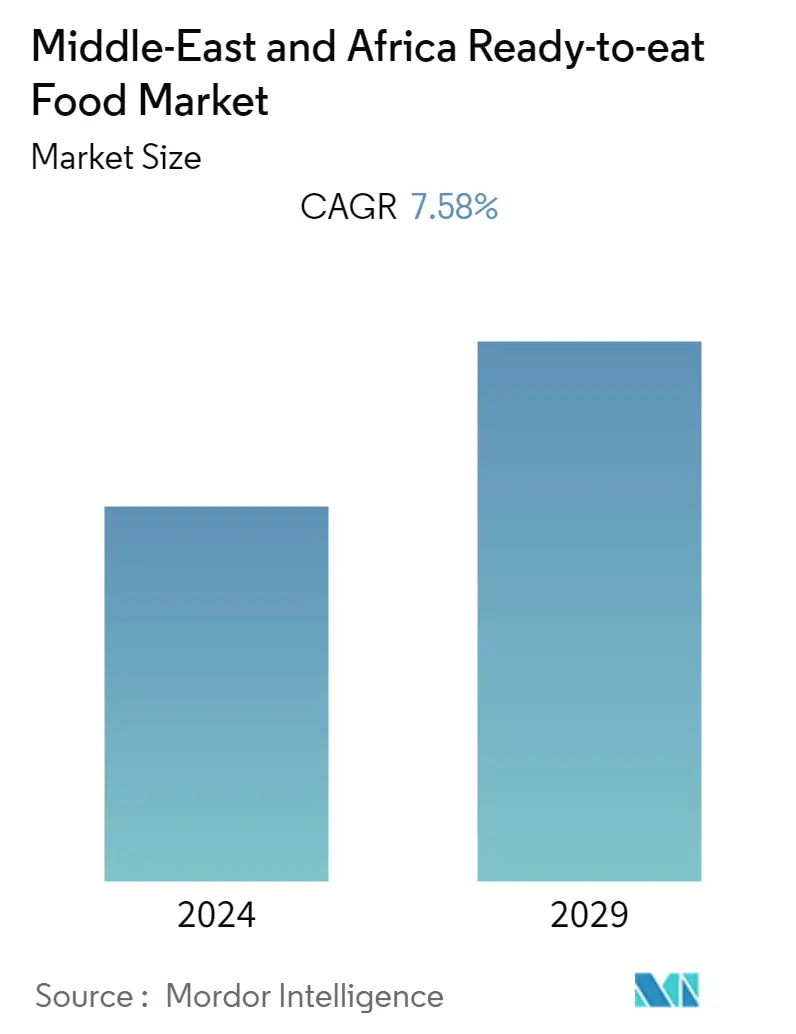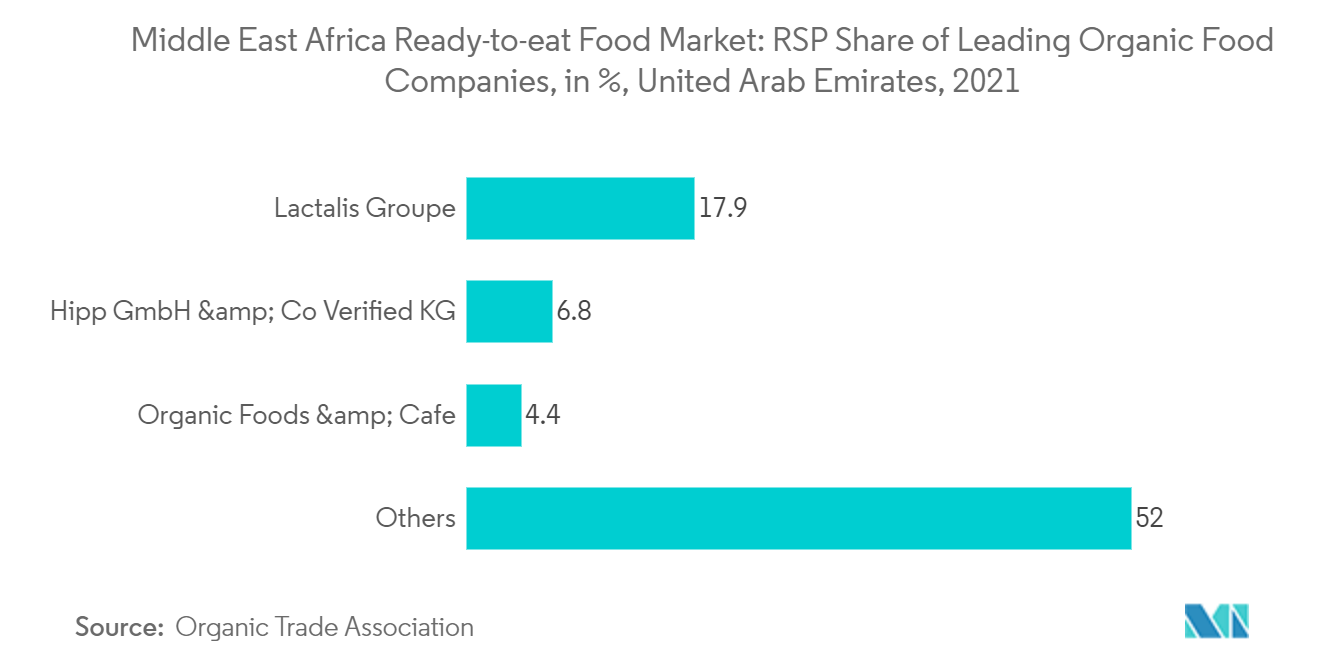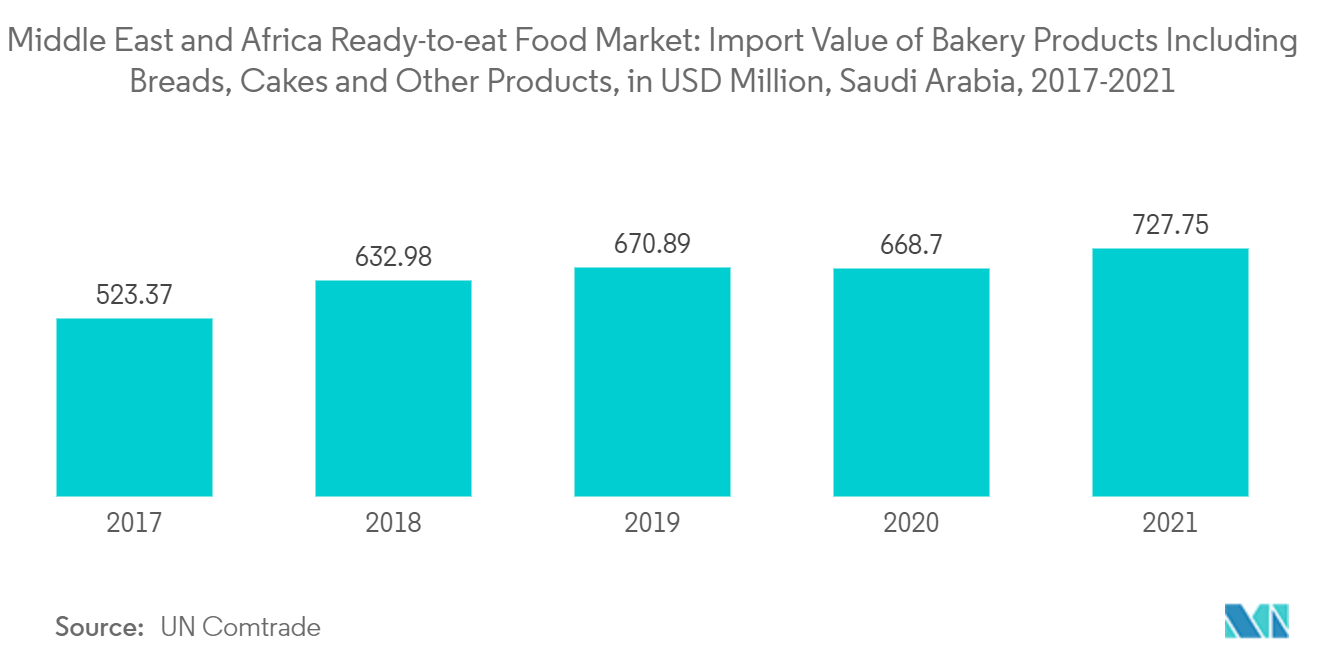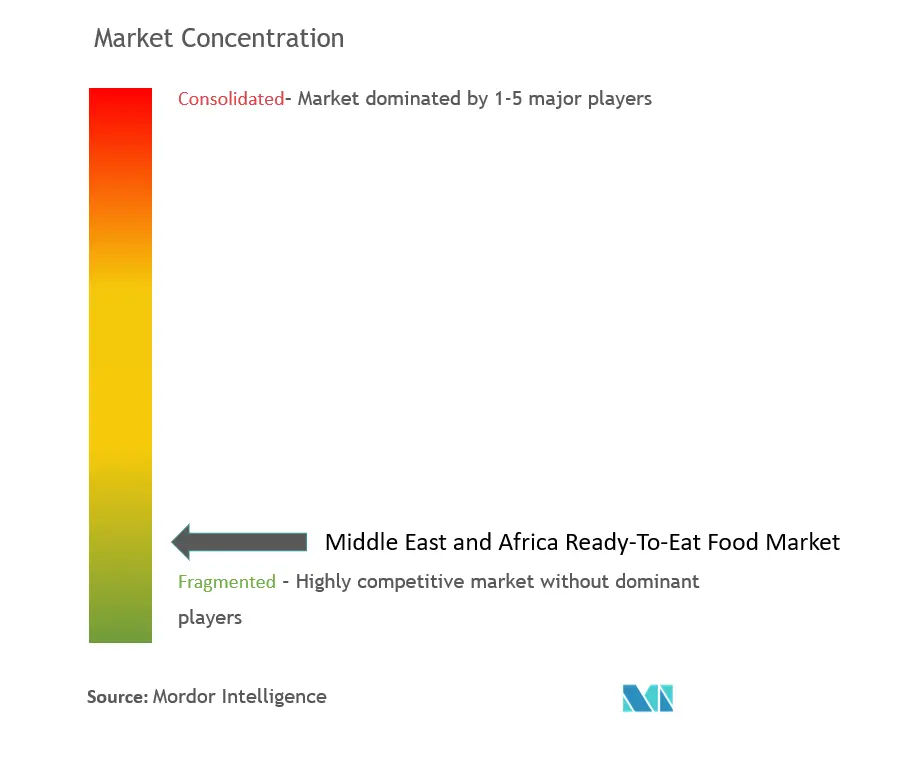MEA Ready-to-eat Food Market Size

| Study Period | 2019 - 2029 |
| Base Year For Estimation | 2023 |
| Forecast Data Period | 2024 - 2029 |
| Historical Data Period | 2019 - 2022 |
| CAGR | 7.58 % |
| Market Concentration | Low |
Major Players
*Disclaimer: Major Players sorted in no particular order |
MEA Ready-to-eat Food Market Analysis
Over the next few years, the Middle East and Africa Ready-to-Eat Food Market is expected to register a CAGR of 7.58 %.
The major factor driving the growth of the ready-to-eat food market is convenience. Young consumers spend most of their income on convenient, ready-to-eat food products. Other factors affecting the market are the changing food consumption patterns due to increasing urbanization, which is driving the ready-to-eat food market in the region. In addition, a high focus on exports, the adaptation of new technologies, innovative promotional techniques, gaining special attention in retail format stores, retailers going for private label ready-to-eat meals, launching innovative and region-specific products, and frozen ready-to-eat products gaining popularity are other factors fueling the market's growth.
The demand for healthy convenience foods and processed foods such as ready-to-eat foods is increasing. To take advantage of such opportunities in the market, new players have been entering it. For example, in March 2022, the startup company Nowadays Trading launched FatBroccoli products, which offer naturally sourced, locally manufactured, nutritious frozen foods. The healthful fast food was initially sold in places with heavy foot traffic, such as schools, gyms, universities, hospitals, gas stations, government buildings, service centers, airports, and others. To further its reach beyond the United Arab Emirates, FatBroccoli revealed its plans to open 20 additional locations in other GCC regions. With the rise in urbanization, a growing middle-class population, an increase in the number of working women, and a rise in disposable income, the region has been witnessing a rising demand for ready-to-eat products such as biscuits, cakes, breakfast cereals, and other such items as they are more convenient than complex traditional home-made items, which take much longer to prepare. Further, new hybrid working patterns and significant investments people made in their homes in the post-pandemic era point to a larger number of ready-to-eat food products consumed at home for the foreseeable future.
MEA Ready-to-eat Food Market Trends
This section covers the major market trends shaping the MEA Ready-to-eat Food Market according to our research experts:
Inclination Towards Healthier and Organic Ready-to-Eat Products
Although the demand for convenience food on-the-go is increasing, several groups of consumers are more conscious of their health. They are inclined toward healthy snack products, aiding the growth of healthy ready-to-eat food products. The growing prevalence of lifestyle disorders such as atherosclerosis, stroke, diabetes, and obesity has increased the inclination toward healthy ready-to-eat products such as nuts, fruit snacks, snack bars, and other confectionery snack products. Hence, the players in the market have been introducing healthy food products to cater to the demand for healthy convenience foods. For example, in February 2022, the United Arab Emirates-based food company Freakin' Healthy announced that it would be adding a new plant-based cheese spread to its line of healthier foods.
Consumers have had a significant demand for natural and organic food products in recent years. Consumers are becoming more aware of the adverse health effects associated with the consumption of various synthetic food ingredients, such as colorants, flavors, texturizers, fat replacers, and sweeteners, owing to multiple research projects and bans introduced by governments. These health issues have led to a consumer shift toward natural additives. According to the Dubai Chamber of Commerce and Industry, the value of free-from food sales in the United Arab Emirates will amount to over USD 33 million in 2020. The CAGR was projected to reach 10% between 2020 and 2025.

Rising Demand for Baked Goods in the Region
The market for ready-to-eat bakery products in the Middle East and Africa is being driven by people's growing interest in wheat products and their desire for easy-to-eat baked goods.The manufacturers are also providing customers with clean labels for better transparency. This provides the customers with a clear picture of what is used in making the products they consume. In addition, products such as preservative-free, gluten-free, cholesterol-free, GMO-free, and low sodium products are being frequently launched by the leading baked goods players that are suitable for diabetics and are rich in fiber, protein, and calcium to meet the consumers' demand, especially those who are health-conscious. According to UN Comtrade data, the imports of bakery products, such as bread, cakes, and other products, into Saudi Arabia increased from USD 668.7 million in 2020 to USD 727.75 million in 2021.
Furthermore, the inclusion of pulses, seeds, and beans, such as broad beans, fava beans, and kidney beans, in cookies provides consumers with the necessary proteins. Domestic players dominate the market, with many small and medium-sized companies competing for market share. For instance, Al Meera, one of Qatar's largest hypermarket and supermarket retail companies, has its bakery product manufacturing plant at Al Oumara Bakeries Company W.L.L. Owing to the growth of the demand for baked goods in the market, new players have been entering the market to take advantage of the opportunities offered by the region's market. For example, in March 2022, the online channel sales company of Yldz Holding expanded its business by entering the United Arab Emirates with the products of the leading Turkish confectionary maker's biscuit brand Ülker.

MEA Ready-to-eat Food Industry Overview
The Middle East and African ready-to-eat food markets are highly fragmented, with a large number of domestic and multinational players competing for market share. Product innovations and partnerships were the two strategic approaches widely adopted by the leading companies across the region to boost their brand presence among consumers. Key players dominating the regional market include Mondelez International, Inc.; Conagra Brands, Inc.; Grupo Bimbo; and McCain Foods Limited. In addition, companies operating in the market studied, such as Siwar Foods, Rhodes Food Group, and others, build the equity of their brands over time with strong consumer-directed marketing, innovative new products, and effective merchandising. As these companies believe the brand-building approach is the key to winning and sustaining leading share positions in markets around the region, they have been consistently investing in advertising expenses to further spread knowledge of RTE food and other food categories among consumers.
MEA Ready-to-eat Food Market Leaders
-
Mondelēz International, Inc.
-
General Mills, Inc.
-
Grupo Bimbo
-
Conagra Brands, Inc.
-
McCain Foods Limited
*Disclaimer: Major Players sorted in no particular order

MEA Ready-to-eat Food Market News
- December 2022: DELY Waffles and Siwar Foods announced that they had signed an agreement to offer frozen waffles in the Kingdom of Saudi Arabia and the GCC region. The deal was meant for Siwar to launch a range of frozen waffles under its own brand in the Kingdom of Saudi Arabia and GCC markets. The products were available through retail and food service distribution channels.
- October 2022: As part of its strategy to grow in Africa, Britannia Industries Ltd., one of the most renowned cookie manufacturers in India, secured a deal for operations in Kenya. The business partnered with Nairobi-based Kenafric Industries to pay USD 20 million for Britannia Foods Ltd., which was funded by Catalyst Capital, as well as purchase real estate and a manufacturing facility.
- June 2022: A new line of ready-to-eat frozen meals and desserts was introduced by Siwar Foods, a Saudi FMCG brand. The convenience product line, which included rice and pasta dishes, was initially sold in brick-and-mortar stores, online, at "Chef in a Box" vending machines, and in a few other retail channels.
MEA Ready-to-eat Food Market Report - Table of Contents
1. INTRODUCTION
- 1.1 Study Assumptions and Market Definition
- 1.2 Scope of the Study
2. RESEARCH METHODOLOGY
3. EXECUTIVE SUMMARY
4. MARKET DYNAMICS
- 4.1 Market Drivers
- 4.2 Market Restraints
-
4.3 Porter's Five Forces Analysis
- 4.3.1 Threat of New Entrants
- 4.3.2 Bargaining Power of Buyers/Consumers
- 4.3.3 Bargaining Power of Suppliers
- 4.3.4 Threat of Substitute Products
- 4.3.5 Intensity of Competitive Rivalry
5. MARKET SEGMENTATION
-
5.1 Product Type
- 5.1.1 Instant Breakfast/Cereals
- 5.1.2 Instant Soups and Snacks
- 5.1.3 Ready Meals
- 5.1.4 Baked Goods
- 5.1.5 Meat Products
- 5.1.6 Other Product Types
-
5.2 Distribution Channel
- 5.2.1 Hypermarkets/Supermarkets
- 5.2.2 Convenience Stores
- 5.2.3 Specialty Stores
- 5.2.4 Online Retail Stores
- 5.2.5 Other Distribution Channels
-
5.3 Geography
- 5.3.1 South Africa
- 5.3.2 Saudi Arabia
- 5.3.3 Rest of Middle-East and Africa
6. COMPETITIVE LANDSCAPE
- 6.1 Strategies Adopted by Leading Players
- 6.2 Market Position Analysis
-
6.3 Company Profiles
- 6.3.1 Unilever PLC
- 6.3.2 McCain Foods Limited
- 6.3.3 Rhodes Food Group
- 6.3.4 The Kraft Heinz Company
- 6.3.5 Grupo Bimbo, S.A.B. de C.V.
- 6.3.6 Saahtain Group
- 6.3.7 Conagra Brands, Inc.
- 6.3.8 General Mills, Inc.
- 6.3.9 Britannia Industries Limited
- 6.3.10 Siwar Foods
- 6.3.11 Mondelēz International, Inc.
- 6.3.12 Nestlé S.A.
- *List Not Exhaustive
7. MARKET OPPORTUNITIES AND FUTURE TRENDS
** Subject To AvailablityMEA Ready-to-eat Food Industry Segmentation
Ready-to-eat (RTE) foods are a group of food products that are pre-cleaned, pre-cooked, mostly packaged, and ready for consumption without prior preparation or cooking. The ready-to-eat food market in the Middle East and Africa is segmented by product type, distribution channel, and country. By product type, the market is segmented into instant breakfast/cereals, instant soups and snacks, ready meals, baked goods, meat products, and other product types. By distribution channel, the market is segmented into hypermarkets and supermarkets, convenience stores, specialty stores, online retail stores, and other distribution channels. The study also provides an analysis of the ready-to-eat food market in emerging and established markets across the Middle East and Africa, including South Africa, Saudi Arabia, and the rest of the Middle East and Africa. For each segment, the market sizing and forecasts have been done on the basis of value (in USD million).
| Product Type | Instant Breakfast/Cereals |
| Instant Soups and Snacks | |
| Ready Meals | |
| Baked Goods | |
| Meat Products | |
| Other Product Types | |
| Distribution Channel | Hypermarkets/Supermarkets |
| Convenience Stores | |
| Specialty Stores | |
| Online Retail Stores | |
| Other Distribution Channels | |
| Geography | South Africa |
| Saudi Arabia | |
| Rest of Middle-East and Africa |
MEA Ready-to-eat Food Market Research FAQs
What is the current Middle-East and Africa Ready-to-eat Food Market size?
The Middle-East and Africa Ready-to-eat Food Market is projected to register a CAGR of 7.58% during the forecast period (2024-2029)
Who are the key players in Middle-East and Africa Ready-to-eat Food Market?
Mondelēz International, Inc. , General Mills, Inc., Grupo Bimbo, Conagra Brands, Inc. and McCain Foods Limited are the major companies operating in the Middle-East and Africa Ready-to-eat Food Market.
What years does this Middle-East and Africa Ready-to-eat Food Market cover?
The report covers the Middle-East and Africa Ready-to-eat Food Market historical market size for years: 2019, 2020, 2021, 2022 and 2023. The report also forecasts the Middle-East and Africa Ready-to-eat Food Market size for years: 2024, 2025, 2026, 2027, 2028 and 2029.
MEA Ready-to-eat Food Industry Report
Statistics for the 2024 MEA Ready-to-eat Food market share, size and revenue growth rate, created by Mordor Intelligence™ Industry Reports. MEA Ready-to-eat Food analysis includes a market forecast outlook to 2029 and historical overview. Get a sample of this industry analysis as a free report PDF download.



